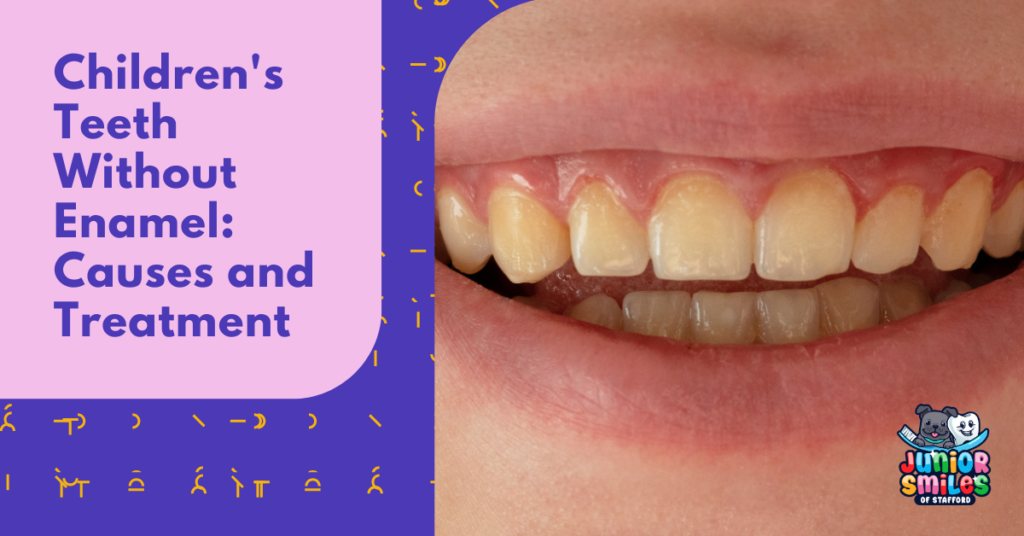Children’s Teeth Without Enamel: Causes and Treatment

The outermost and protective layer of the teeth is called enamel. Tooth enamel is the hardest surface in your body, and it also gives your teeth a white look. Your teeth can’t withstand the strain of normal biting and chewing if they lack this protective layer. However, there are rare cases where kids develop teeth without enamel. This medical condition is called enamel hypoplasia.
Enamel Hypoplasia
Enamel hypoplasia is a developmental enamel defect that occurs prior to the eruption of the affected tooth from the gums. In comparison, enamel wear happens after a tooth has erupted, such as dental abrasion and erosion.
Dental enamel hypoplasia is a dental enamel defect characterized by thin or missing enamel. The defect arises on only a portion of a tooth’s surface in certain circumstances, resulting in pits or grooves in the tooth’s enamel. In some instances, an entire tooth may have a fragile covering of dental enamel or may be completely devoid of enamel.
Symptoms
Some symptoms may not be noticeable until they cause further major dental problems, so it would be best to visit your pediatric dentist regularly. Although, here are some signs to check:
- yellowish-brown stains
- heat and cold sensitivity
- pits and tiny grooves
- higher susceptibility to tooth decay and cavities in the teeth
- depression and fissures
- retention of harmful bacteria
- vulnerability to acids in food and drink
What Causes Teeth Without Enamel
This dental condition develops when the specific cells responsible for creating tooth enamel are damaged at a particular point in their development. A wide range of causes, including both hereditary and environmental influences, may be responsible for such a disturbance. In children, enamel hypoplasia is caused by rare hereditary factors such as amelogenesis imperfecta, congenital enamel hypoplasia, and Ellis van-Creveld syndrome, which are inherited from parents who have the condition. However, please note that there are several possible causes of congenital enamel hypoplasia, and it can occur independently or as part of a larger disease.
There are several prenatal conditions that can cause enamel hypoplasia:
- Low birth weight or premature birth
- Mother using drugs or smoking
- Maternal weight gain
- Lack of prenatal care
- Mother lacking vitamin D
On the other hand, there are other environmental factors and other infancy problems that can result in enamel hypoplasia:
- infection while pregnant
- calcium deficiency
- liver disease
- Vitamin A, C, or D deficiency
- cerebral palsy caused by prenatal or maternal infection
- trauma to the teeth or jaw
How To Treat Teeth Without Enamel
Early detection and diagnosis are very important. It would be best to bring your kid to your dentist between their first tooth appearance and first birthday. Minor defects that aren’t causing damage or sensitivity can be put off. However, they still need to be kept an eye on. Your child might get fluoride treatment from your dentist to keep your teeth safe.
If your pediatric dentist thinks that enamel hypoplasia is causing many problems with biting, they might recommend dental restorations like white fillings. In some cases, white fillings may not be the best choice because they may not be able to stick to the teeth and healthy teeth.
However, your dentist might recommend dental crowns if the problem is severe. Covering hypoplastic teeth with dental crowns will protect them and make them look and work better.
Moreover, to improve and strengthen your child’s weak enamel, keep your child’s teeth healthy by practicing proper oral hygiene. Teach and encourage your kid to brush their teeth daily, at least twice, using a soft-bristled toothbrush. Make sure to bring your kid to the dentist regularly and whenever your kids show signs of dental problems. It would be best to keep your kids away from sugary drinks and food and ensure that they rinse thoroughly after consuming too much sugar.
Contact Junior Smiles of Stafford to know more about enamel hypoplasia in baby teeth.
If you feel like your child has an enamel defect, make sure to contact your pediatric dentist right away. There’s no better cure than prevention and early detection.
Read Next: White Spots on My Baby’s Teeth: What is it?
Why Choose Junior Smiles of Stafford?
Our Stafford, VA team is well-versed in working with clients of various ages and backgrounds. They’ll take the time to get to know you and your family’s requirements, and they’ll work with you to design a treatment plan that suits your schedule. Sealants and fluoride treatments are just two of the many preventative care options we provide to keep your mouth healthy.
About Us
Visiting Junior Smiles of Stafford means you’re in good hands when it comes to receiving high-quality care. Your child’s dental health improves with each visit, ensuring a brighter smile for years to come. We adhere to the ADA and AAPD’s guidelines for best practices.
Where Are We Located?
Phone: (540) 699-2441
Fax: (540) 699-2464
Email: info@juniorsmilesofstafford.com
Monday and Tuesday: 9:00 AM – 5:00 PM
Wednesdays and Thursdays: 8:00 AM – 4:00 PM
Fridays and Saturdays: 9:00 AM – 2:00 PM (By appointment only)
How to Book Your Kids First Appointment at Junior Smiles of Stafford
Fill out the form on our website. Within 24 hours, a member of our team will get back to you.

